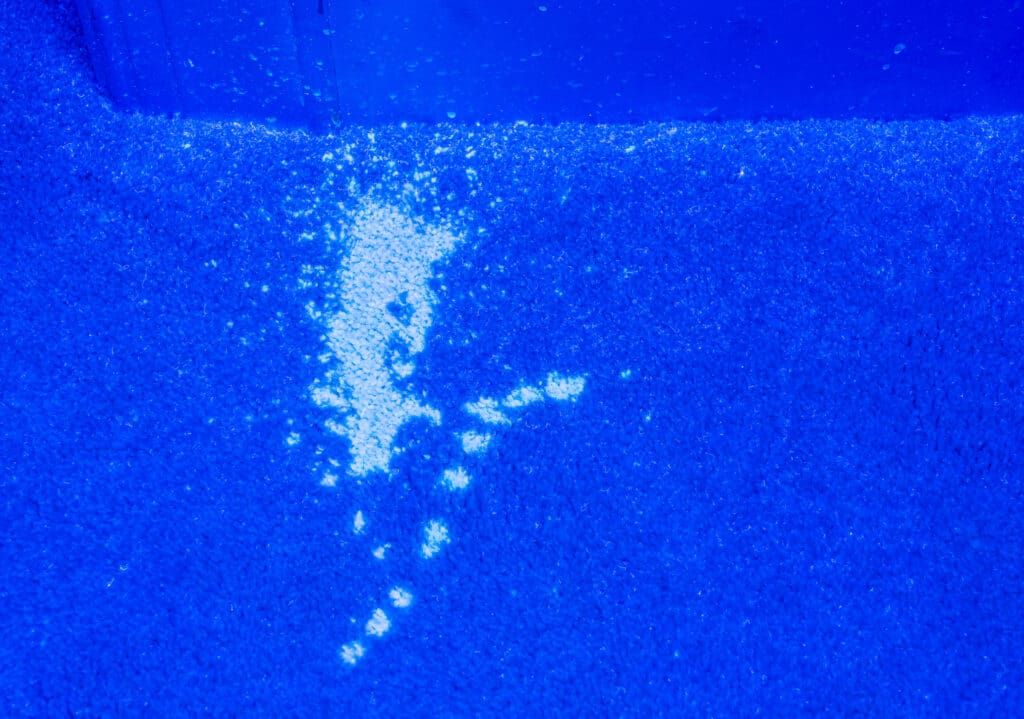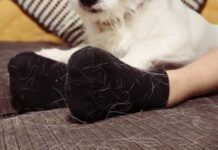Your dog pees on the rug, you clean it up, and the stain remains. Worse, your dog keeps urinating in the same place, even after you apply recommended home remedies like white vinegar and baking soda. Still more bothersome is the smell that sometimes lingers even when the stain itself is no longer visible.
While vinegar and baking soda may mask urine odors for human noses (for a while), dogs have thousands more olfactory receptors than people do. Even if a treated stain initially smells fine to us, your dog can still find it — and dogs like to urinate where they or other dogs have urinated, so the cycle never stops.
Canine urine combines ammonia, bacteria, hormones, and uric acid. As it breaks down, urine’s ammonia becomes more concentrated and releases mercaptan, a putrid-smelling gas containing hydrogen, carbon, and sulfur. This is why it can be difficult to completely get dog urine smell out of carpet, upholstery, and even poorly sealed hardwood, concrete, or tile.

If you are having trouble tracking down the source of the dog urine smell in your house, shine a blacklight such as a Vansky UV Blacklight Pet Urine Detector or Escolite UV Blacklight Flashlight wherever you’ve noticed accidents, plus behind curtains, in dark corners, on or around the dog’s bed or crate, next to houseplants, and near entry doors.
Phosphorus and proteins in urine glow when exposed to blacklight’s wavelengths, so both old and new stains will be obvious along with previously treated stains that were insufficiently cleaned
How to Get Dog Urine Smell Out of Carpet Step by Step
Whenever possible, treat the stain as soon as you notice it with a product such as an enzyme, mineral, or oxidizing cleaner. Fresh urine stains are easier to clean than those that have dried because they haven’t yet set into the carpet, floor surface, or upholstery fabric.
- Read product labels carefully and check manufacturer websites for complete instructions and usage tips. Be sure the product is appropriate for use on your carpet, hardwood floor, tile floor, upholstery, deck, back yard, or other surface.
- If the label recommends starting with a spot test, apply a small amount to an inconspicuous section following label directions, then check for discoloration or damage. If there’s a problem, use a different product.
- Be sure you have enough product to completely cover the affected area because large or old stains may need more cleaner, take longer to treat, or need a second application.
- Because urine can soak into carpet, its underlayers, and even subflooring, apply enough cleaner to penetrate as deeply as the urine did.
- If recommended, blot the treated stain with absorbent towels to remove as much moisture as possible, then speed the area’s drying with open windows, fans, a wet vacuum, or carpet cleaner to prevent trapped moisture from causing mold or mildew.
Using Enzyme Cleaners for Dog Urine
Enzymes are naturally occurring proteins that act as catalysts, speeding chemical reactions. Specific enzymes break down or “digest” the proteins, starches, and fats in urine stains so they can be wiped, rinsed, or vacuumed away.
Enzyme cleaners designed for pet use contain uricase, an enzyme that breaks uric acid into carbon dioxide and water, along with other enzymes that work on urine, vomit, fecal matter, stinky dog smells, and other organic stains and odors.
Product labels identify compatible surfaces, such as carpets, area rugs, hardwood floors, tile floors, upholstery, or outdoor locations. Many deodorizing products contain added fragrances, some of which can be intense or unpleasant. Consider starting with an unscented product or compare customer ratings while shopping.
Popular enzyme cleaners for canine urine stains and odor include:
- Bac-Out Biokleen Enzyme Stain & Odor Remover
- Angry Orange Pet Stain Enzyme Cleaner
- Hepper Advanced Bio-Enzyme Pet Stain & Odor Remover
- Simple Solution Extreme Stain & Odor Remover
- Bubba’s Pet Stain & Odor Terminator
- Bissell Professional Pet Urine Eliminator Formula for Carpet Cleaners
- Pets Rule OdoBan Pet Stain and Odor Remover
- Nature’s Miracle Dog Stain and Odor Remover
How Mineral Deodorizers Remove Dog Urine
Mineral-based deodorizers often list their ingredients as a “proprietary blend” or “biodegradable molecular complex” that breaks down urine, vomit, and fecal stains at the molecular level.
It’s impossible to know what they contain but that doesn’t matter to fans of mineral deodorizers because these products are designed to remove organic stains and odors on contact. Some formulas, like Pooph, deodorize waste-water treatment plants, landfills, recycling plants, farms, and hospitals. Some mineral-based products can be added to laundry; used to treat lawns, artificial turf, and decks; or are safe for direct application to your dog.
Mineral-based cleaners include:
- Skouts Honor Pet Urine Destroyer
- Pooph Pet Stain and Odor Remover
- Parker & Bailey Pet Stain & Odor Eliminator
- Dynamic Element Pet Odor Eliminator Spray
- Zeofill Back Yard Granular Deodorizer and Pet Urine Odor Neutralizing Spray
Oxidizing Cleaners: Does Hydrogen Peroxide Neutralizes Dog Urine
Oxidizing (oxy) cleaners are popular laundry products, and several pet stain removers rely on oxidizing hydrogen peroxide to treat canine urine and other stains. Oxidation breaks down and changes chemical compounds into odorless, inert substances. Most oxidizing pet stain removers can be used alone or in conjunction with other stain and odor products. See:
- Stink Free Stain & Urine Odor Eliminator for Pets
- Woolite INSTAclean Pet Stain Remover
- Clorox Urine Odor Remover
- OUT! Oxy-Fast Pet Stain and Odor Remover
Other Dog Urine Cleaners
While enzyme, mineral, and oxidizing cleaners are the most commonly available, there are a few other products that also work for removing dog urine smell from carpet and other surfaces:
- NonScents Pet Stain & Odor Eliminator uses active chlorine to neutralize odors in a product that is non-toxic and safe for use around pets.
- Zero Odor Pet Stain Remover and Odor Eliminator uses molecular technology to chemically alter odor molecules to eliminate them completely.
- Resolve Pet Expert Stain & Odor Remover utilizes bio-based polymer technology to remove odor-causing molecules.
- Fresh Nest Pet Urine Destroyer works at the molecular level to eradicate odors.
- O.E Kennel Odor Eliminator contains a proprietary essential oil blend for indoor and outdoor applications at veterinary clinics, shelters, grooming salons, kennels, and pet homes.
- Apply Guard Pet Odor and Stain Eliminator uses blocking technologies to capture, destroy, and block odor molecules.






